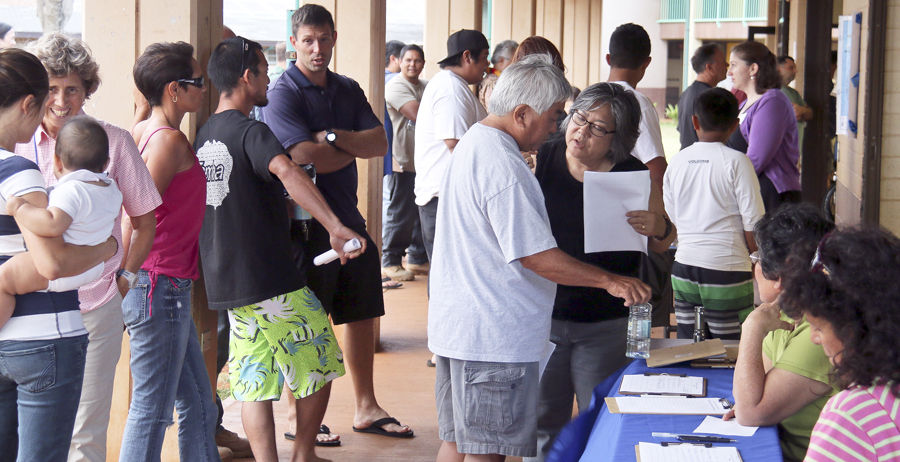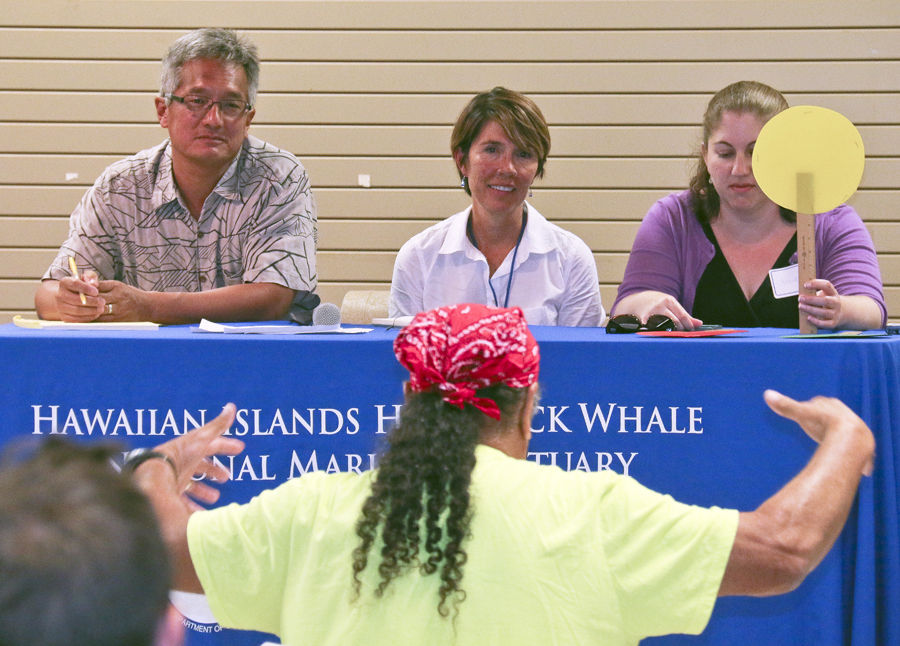LIHUE — Three days of fiery testimony on federally proposed changes to the humpback whale sanctuary concluded in Lihue Wednesday with 50 residents voicing their opinions. The Kauai meetings, part of a statewide tour, marked the “hardest days I’ve ever
LIHUE — Three days of fiery testimony on federally proposed changes to the humpback whale sanctuary concluded in Lihue Wednesday with 50 residents voicing their opinions.
The Kauai meetings, part of a statewide tour, marked the “hardest days I’ve ever had in my life,” said Malia Chow, Sanctuary Superintendent for the National Oceanic and Atmospheric Administration.
Hard because Chow and her colleagues were on the receiving end of widespread anger in the public comments of captains, fishermen, surfers and local business owners, who made it clear they will do whatever it takes to fend off what they view as the increasing oversight of state waters by a federal government they don’t trust.
“I see you coming in with your invisible cape, and some of us are trying to lift it up,” said Kilauea resident Mitchell Alapa, who apologized repeatedly for his profanity-laced protests that caused a ruckus at the first public hearing in his hometown Monday night.
At issue is a new management plan for the Hawaiian Islands Humpback Whale National Marine Sanctuary. The crux of the proposal is a sanctuary boundary expansion to include 235 square miles of new state and federal waters around Kauai, Niihau and Oahu, bringing the total sanctuary area to 1,601 square miles. The plan would also extend the sanctuary’s focus from just whales to other marine species and generate new opportunities to work closely with community groups on priority resource protection issues.
Much like during the first two meetings — Nearly 100 people testified in Waimea Tuesday while a couple dozen spoke Monday in Kilauea — Wednesday’s gathering was dominated by people who opposed the plan. The scheduled three-hour meeting was still going on as of press time.
Chow started the meeting by pointing out all proposed changes to the current sanctuary border are the result of requests made by community members. For example, she said, the Robinson family that owns Niihau requested that the waters around the perimeter of the private island be included in the sanctuary.
All told, the plan calls for a 16 percent expansion of sanctuary waters around Kauai, with add-ons in Haena, Hanalei and Kilauea. But it’s the three-nautical mile expansion around Niihau that’s drawing the most fire from locals who fish there.
Greg Holzman, a commercial fisherman from Kekaha, said 85 percent of his fishing grounds are within the proposed sanctuary expansion borders, and he fears that he will eventually be shut out.
You might say his fears are well-reasoned. In 2013, the Robinson family asked the state to establish a “no-fishing zone” around the entire island for all people other than the small resident population of Niihau Island. This is the same family that requested that Niihau waters be included in the sanctuary expansion.
But restrictions on fishing have no part in NOAA’s proposed expansion. In fact, preserving sanctuary waters for fishing, diving and surfing — not just for the protection of the humpback whale — is all part of the plan’s intent, Chow said.
“The proposal of Niihau — I’m sure you don’t believe me, but we can have a conversation later — is included in here so that we can connote resources and efforts to programs on the ground to better understand (these waters),” Chow said.
To be clear: “This is not designed to limit fishing,” she added.
Anne Walton, the sanctuary’s program analyst, said about 60 people attended the public hearing on Niihau Tuesday and about 10 of them submitted public comment. Most of the testimony was in support of the sanctuary, but under certain conditions, she said.
“For the most part they wanted more protection for monk seals and more protection for fisheries’ resources,” she said.
She said no one specifically said they wanted Niihau waters closed off to fishing as a means of achieving those enhanced protections.
Co-managed by the NOAA and the state of Hawaii, the sanctuary aims to protect humpback whales and their habitat.
It is one of the most important humpback habitats in the world.
Not everyone Wednesday spoke in opposition of the sanctuary proposal.
“For me, for Kauai, the sanctuary is a partner and helps us when we ask,” said Maka’ala Ka’aumoana, executive director of the Hanalei Watershed Hui.




